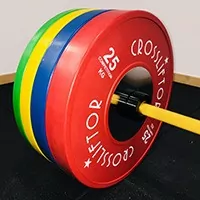What are crosstraining grips for?
When you're doing crosstraining, you're going to be repeating a lot of movements like pull-ups, toes-to-bar, chest-to-bar and muscle-ups. Performing these movements in a kipping (swinging) motion causes intense friction for your hands, and over time will lead to blisters and calluses. Gym grips will protect your hands, give you a better grip on smooth-coated bars and enable you to perform more repetitions. Depending on the type of grips you choose, you'll get a better grip and less fatigue for your wrists and forearms. Hand protectors are essential accessories for regular crosstraining.
As an accessory and depending on preference, they can also be used for weightlifting movements which, when repeated at high intensity, will also tire your hands and prevent you from performing well in WODs.
How to choose your grips?
There are two main criteria to take into account when choosing your grips.
The size of your hands
Depending on the size of your hands, you'll have a choice of grips with different widths and thicknesses. If you like to feel the bar a little to get a good feel for your grip, then prefer a width between 1 and 2.5 mm. For the size, you simply need to be able to cover the width of your palm. With sizes ranging from S to XL for the largest, you need to choose according to the height between your wrist and the beginning of your fingers. This may vary from brand to brand, but generally speaking, choose S below 10 cm. M between 10 cm and 11 cm, then L up to around 13 cm. If you have the opportunity to try them on, that's even better, but in any case, beginner or not, don't make the mistake of buying poor-quality grips, as you'll soon be limited.
The number of holes
On this page, you'll find grips with a number of finger holes ranging from 2 to 3 holes, to full finger holes. It all depends on your preference. If you like to feel the bar a little and want to protect only your middle and index fingers, then two holes will suffice. If not, then three holes are preferable, even though we see a lot of practitioners using grips without holes. Your fingers will be completely covered and your hand fully protected. These are very good sizes for medium to advanced practitioners, with sufficient grip to wrap the bar around the grips.
Manufacturing materials
Leather, silicone, fabric or carbon are the materials of choice. Carbon potholders are extremely resistant but rather rigid. Leather grips, on the other hand, fit the shape of your hand perfectly and act as a second skin. It all depends on your preferences and your budget. If you're a beginner, it's not necessarily necessary to invest in carbon grips.
What are the best gymnastic grips for WOD?
It's hard to say which are the best gymnastics grips. But if you have a decent budget and plan to practice frequently, we'd advise you to go for a model like Victory Grips' Freedom X2. Their synthetic material has been specially designed for perfect endurance and grip, with ideal flexibility and rigidity, they are extremely resistant and comfortable.
Our advice for using your gym grips at the barre
Depending on the model you choose, for example 2 or 3 holes, don't hesitate to apply magnesia to the protective layer in contact with the bar of your grips. If you buy potholders without holes, with a good wrist attachment, squeeze them tightly in the upper position, and place your fingers around them, thumb above (depending on the exercises and the target objective). The weight will be more evenly distributed over the wrist and forearm, and you'll tire your finger grip less.
How to care for your grips
To clean your grips, simply use neutral soap such as Marseille soap, water at room temperature and allow them to dry for a sufficiently long time. If you wash your potholders in a washing machine, be careful not to use a program above 30 degrees. Some materials are not designed to withstand this. The best thing to do is rub them by hand or leave them to soak.










 (1).webp)








































